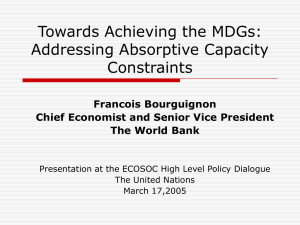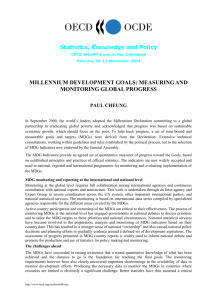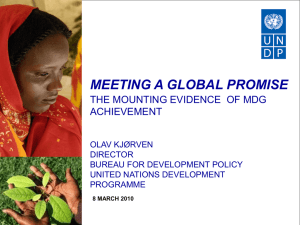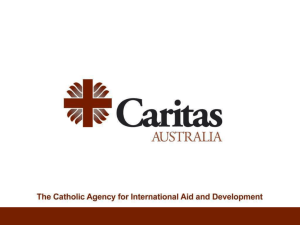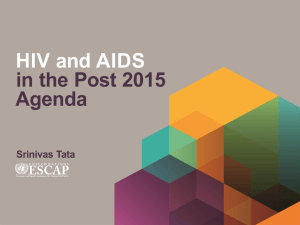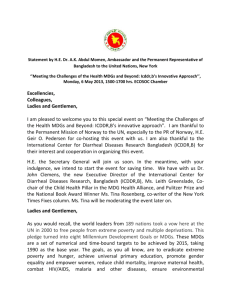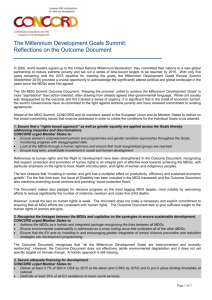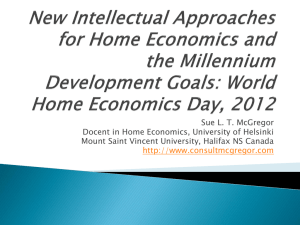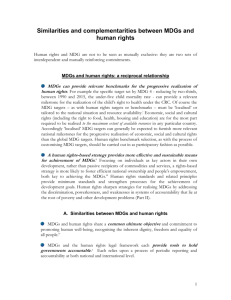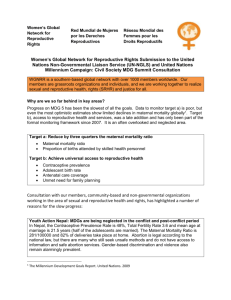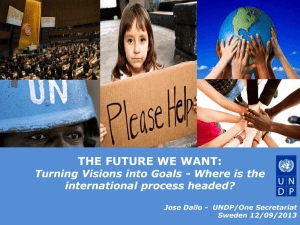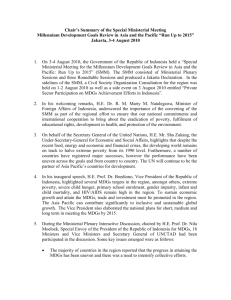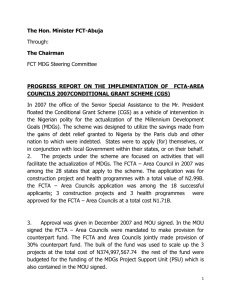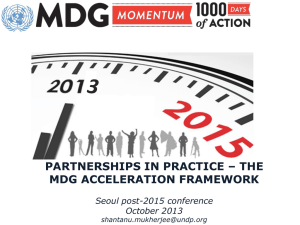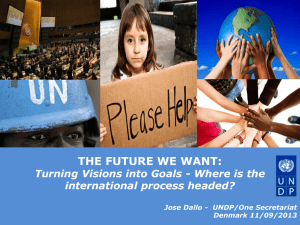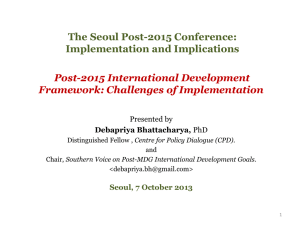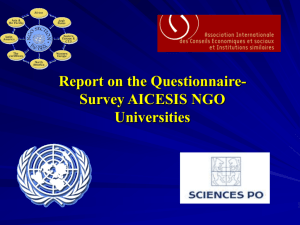Gordon Manuain
advertisement
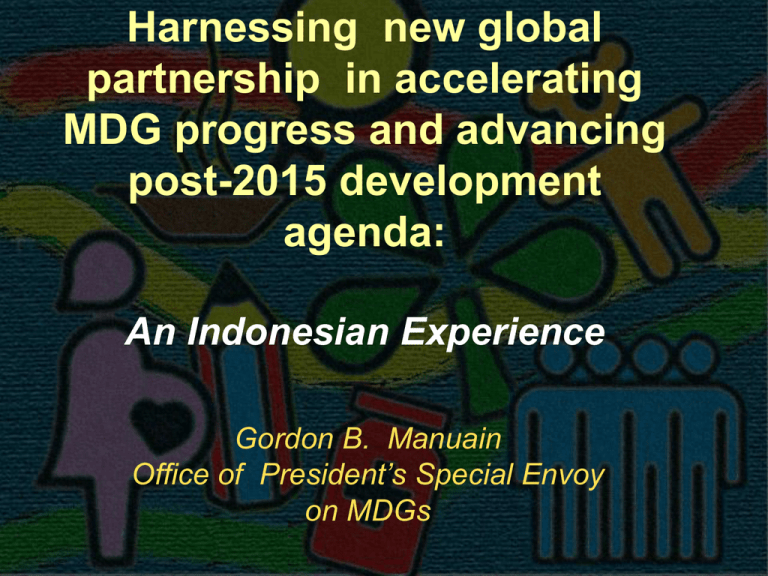
Harnessing new global partnership in accelerating MDG progress and advancing post-2015 development agenda: An Indonesian Experience Gordon B. Manuain Office of President’s Special Envoy on MDGs Current MDG Status in Indonesia Targets already achieved Targets on- track to be achieved by 2015 Targets requiring hard work to be achieved by 2015 MDG-1 Poverty alleviation MDG-1 Decrease in MDG-5 High maternal prevalence of underweight mortality children under five MDG-3 Gender equality MDG-2 Net enrollment rate MDG-6 Increased for primary education and proportion of people with literacy rate of population HIV/AIDS in all types and levels of education MDG-3 Net enrollment MDG-6 Decrease in tuberculosis prevalence ratios of girls to boys in secondary and higher education MDG-4 Decreased mortality rate of children under five MDG-8 Global partnership MDG-7 High level of greenhouse gas emissions, and safe drinking water & sanitation Unique challenges in achieving MDGs (Geographical perspective) Geography – – – – Number of islands: 17,508 East to West Distance: 5,120 km, equivalent to London - Moscow North to South Distance: 1,760 km 33 provinces and > 450 districts and municipalities Challenges: • Considerable geographical span and barriers • Transportation infrastructure that needs improvement • Access to community health centers in remote areas, resulting in unnecessary delays that often lead to death. Indonesia: the largest archipelagic country in the world Unique challenges in achieving MDGs (Population perspective) Population – A country with the fourth largest population (250 million) – Population growth that outpaces the progress of development made by the government – Family Planning that may not be able to repeat its past success – Pyramid structure of population that calls for more attention when young productive group reaches old age. Indonesian population pyramid Areas of concerns in women’s and children’s health in Indonesia (to be addressed until 2015 and beyond) Progress in improving reproductive health and reducing maternal and newborn mortality must be accelerated. Out-of-box approach, improved synergy of government, CSO, private sector to bring about changes at the grassroots level Access to family planning information and services Infrastructure and facilities Intersectoral coordination Availability of skilled health personnel Nutrition for pregnant mother Access to healthcare services (geographical challenges) Improved inter-sectoral coordination is the sine qua non of success Milestones toward MDG achievement in Indonesia Presidential Instruction No.3 Year 2010 on Equitable Development Program to accelerate the MDG achievement by 2015 National Roadmap to accelerate MDG achievement Mainstreaming of MDGs into National LongTerm and MidTerm Development Plans Mainstreaming of MDGs into National Planning and Expenditure Budget Provincial Action Plan to accelerate MDG achievement Annual Indonesia MDG Awards Sustainable partnership of government, CSO, private sector in accelerating MDG achievement at the grassroots level. Partnership TOP DOWN Government MDGs and post-MDG Agenda Innovative breakthroughs by multi- and intersectoral stakeholders Take the lead Coordinate Facilitate Respond develop Implement Community BOTTOM UP Office of President’s Special Envoy on MDGs www.pencerahnusantara.org Twitter :@pencerahnusa Facebook : Pencerah Nusantara OFFICE OF PRESIDENT’S SPECIAL ENVOY ON MDGS ADVOCACY - EDUCATION INTEGRATED PROGRAMS COMMUNITIES Community Health Condition IMPACT DATABASE MONEV Young Health Advocates Sustainable Funding Support GPs INPUT Capacity Building Infrastructure Information Women Empowerment PRIMARY HEALTHCARE CENTER dentists midwives nurses PRIVATE SECTOR ENDOWMENT OFFICE OF PRESIDENT’S SPECIAL ENVOY ON MDGS Civil society A sustainable model of partnership: “Pencerah Nusantara” • Office of President ‘s Special Envoy on MDGs: – realizes that a partnership among relevant stakeholders is crucial in achieving the MDG targets, and – has set up a model of partnership which brings together private sector, civil society, and government institutions in a collective effort to bring about changes at the grassroots level in several locations in Indonesia. Why “Pencerah Nusantara” (Nation’s Guiding Light) is needed? • We need to translate commitment into concrete action to accelerate the achievement of MDGs. • Pencerah Nusantara: a pilot program that puts into reality our belief that changes should be made at grassroots level through sustainable community empowerment, which can serve as a model to be replicated at a wider level. What sort of enabling conditions are necessary for achieving the new development agenda? Sustainable Development Economic Development & Ending Poverty: • Income poverty • Economic growth • Hunger& • malnutrition • Education • Health • Infrastructure Social Inclusion: • • • • • Gender equality Rights Youth Unemployment Social trust • Environnmental Sustainability • Climate Change • Sustainable agriculture & fisheries • Sustainable cities • Biodiversity • Chemicals • Disaster Peace, Security and Good Governance Public Sector Governance Private Sector & Civil Society Governance Resource Mobilization Five Big Transformative Shifts (Report of High Level Panel of Eminent Persons on Post-2015 Development Agenda) • Leave no one behind • Put sustainable development at the core • Transform economies for jobs and inclusive growth • Build peace and effective, open and accountable institutions for all • Forge a new global partnership. A new global partnership (Report of High Level Panel of Eminent Persons on Post-2015 Development Agenda) • This partnership should not only involve governments but also include others: people living in poverty, those with disabilities, women, civil society and indigenous and local communities, traditionally marginalized groups, multilateral institutions, local and national government, the business community, academia and private philanthropy. • It is time for the international community to use new ways of working, to go beyond an aid agenda…. Exploring innovative ways of development assistance • Governments committed to ODA could take the lead in fostering sustainable partnership with private sector and civil society in designing and developing appropriate development assistance for ODA recipients. • Governments as development partners could create enabling circumstances for private sector to engage in social investment through inclusive business that will bolster the achievement of the MDG targets. Global Partnership National Policies PROBLEM of ‘POVERTY’ Job Economic Inclusive Growth Government’s strategy for sustainable development Nutrition Population Housing Health Education Environmental sustainability ENVIRONMENT Affordable access to basic needs Clean water Sanitation Energy Across Sector Partnership Youth Groups/Students: • Mass campaign, social media • Role model Inclusive, • Peer education Integrated • Action-oriented • • Collaborative Action • • Government Advocate at National and Local Government level Create enabling environment • • Private Sector: Develop, scale up, and perfect sustainable partnerships Replicate corporate value Civil Society Community Capacity Building Evaluation, Feedback and Reporting Collective Action toward MDGs by 2015 and Beyond Government Civil Society Office of Special Envoy on MDGs Private sector MDGs 2015 Post -2015 development agenda with sustainable development at the core Community MDGs: Unfinished agenda to be pursued after 2015 Thank you Office of President’s Special Envoy on the MDGs

